Disciples II: Dark Prophecy Preview
We take an extensive look at the upcoming turn-based strategy game.
Sequels are always supposed to improve on their predecessors. Even if the original game is a bona fide classic with legions of adoring fans, the follow-up has to be bigger and better in just about every way. Of course, that isn't always the case. You don't have to look too far to see examples of sequels that either drop the ball or change the gameplay so much that the original concepts are unrecognizable.
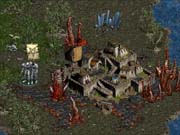
That doesn't seem to be the case with Disciples II: Dark Prophecy. The next episode in the saga that began in 1999 with Disciples: Sacred Lands looks to be a revamped and expanded version of the original. That's great news for those who enjoyed the first title, which won a great deal of acclaim and was even recognized as GameSpot's Best Game No One Played. An ambiguous award, perhaps, but such acknowledgement does set the stage for the upcoming game to be a success both critically and commercially.
"Some very good things were done with Disciples, but there are lots and lots of additional possibilities now," explained Disciples II creative director Danny Belanger when we visited him and the rest of the design team at Strategy First's Montreal headquarters recently. "The challenge was to make a new and bigger game while keeping the Disciples structure intact. We want to keep the Disciples fan and not change things too much, but we also want to attract new people."
To achieve this goal, many of the basic elements introduced in Disciples will be returning in Disciples II. The essential structure of the game remains the same. You still guide each of the four core races--the Empire, the Mountain Clans, the Legions of the Damned, and the Undead Hordes--in separate campaigns aiming to conquer the sacred lands. This time, however, each race is in chaos. The Great Wars of the first game have left devastation in their wake, and even though a decade has passed, everyone is still feeling their effects. The human Empire is struggling with famine and disease, while the dwarven Mountain Clans still mourn the death of their great king. Over on the evil side of the ledger, the Legions of the Damned are still recovering from the destruction of their armies in the wars, and the Undead Hordes are either in disarray or just plain dead (meaning really dead).
Into this happy mix comes the Chosen One, a prophesied savior who means different things to each of the races. This mysterious figure is a key component in every campaign. You'll see the same events from different perspectives, depending upon which race you're playing. For example, while the Undead Hordes see their defeat of the high king of the Mountain Clans as a great victory, the Mountain Clans view this as a catastrophe. Exactly how the Chosen One fits into the rivalries established by the four races in the first game is still being determined, though you can be sure that his role will be twisted by each race for its own purposes.
Quests and Campaigns
Gameplay should be very similar to that in the original Disciples. You'll still guide parties of up to six adventurers on missions across the land, battling enemy forces and conquering territory for the gold needed to build structures and the mana required to cast and research spells. According to Belanger, though, the "RPG feel has been amplified" in the new game with "more storylines and more depth." Between 20 and 30 triggers for subquests have been added, allowing you more interaction with the world outside of the linear events in each campaign. The example we were shown involved the awakening of an ancient red dragon hostile to all of the races. For a time, the Undead Hordes and the Empire needed to abandon their mutual antagonism and take care of this threat.
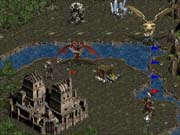
Miscellaneous neutral creatures in the game, like the red dragon mentioned above, now have their own AI and are grouped by type so they don't attack one another. For example, members of the green-skin class such as trolls and ogres will leave each other alone, as will the members of other groups like water, dragons, marsh, and so on. Unlike the original Disciples, monsters unaffiliated with the four warring sides here will react to your parties. They may attack you, or they may offer their assistance, depending on the situation. You might even sign up the help of an orc to get your party into an orc stronghold without encountering a lot of bloody resistance along the way. While incorporating these elements, Belanger said he guarded against making Disciples II too quest-intensive or too much of a role-playing game. "One thing I didn't want was to make Disciples II a puzzle game. This is still a strategy game. I stayed away from linking subquests to major quests specifically because I didn't want to make players do Quest A in order to do Quest B."
These quests and the larger campaigns have been refined with the addition of more unit types with unique abilities and significantly larger unit development trees. While you still must build structures to create units--for example, you still need a dungeon to turn a squire into a witch hunter--new options increase the strategic importance of making the right decisions when advancing your units. At the time of our visit, the Empire's unit development tree featured eight new units. The acolyte can now move up to hierophant or prophetess, depending upon which path is followed, while the squire has the option of choosing between the holy avenger, defender of the faith, and grand inquisitor jobs, and the archer can become an assassin. Each race features between 32 and 40 units in total, including new and old ones.
The apprentice's development features the most important new twist. After moving up to mage, this unit can either follow the same branch from the original game to wizard or head along a new path to elementalist. This represents a serious change in your approach to the game, as the elementalist's talent lies with summoning an air elemental, and therefore he isn't as offensively skilled as the wizard, who can cast a lightning spell. Still, the elementalist may prove very useful because his summoned creatures can attack enemy structures directly, while the wizard's spell can't be directed at such buildings. Choices like this obviously embellish strategic elements of the game and let you play each race in very different ways each time through a campaign. Replayability should be a strong point of Disciples II.
Units and New Items
Of course, you can also choose to remain at a lower class and simply level up from there. Even though the witch hunter's powerful sword attack might seem very attractive, you might choose to save on building costs and not build the dungeon needed to create this unit. You could then stay as a squire with more powerful skills and attributes. The same goes for the archer's development tree, where you might value a powerful marksman more than the next step along the character's progression, the assassin. Making these options more attractive is an increase in level maximums. Units now don't max out until level 137, making advancement virtually unlimited in terms of campaign play.
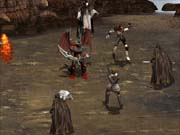
Although the unit development trees might very well be the heart of Disciples II, leaders are also vital. These characters function as the heads of each party, with the other members consisting of the unit types outlined above. Each has different attributes that change and increase as levels advance. Empire leaders, for example, include the Pegasus knight, who fights with his lance; the archmage, who has the ability to cast a powerful lightning spell; and the archangel, who boasts powerful healing magic. Additionally, you can now customize the names of leaders--an option that was lacking in the first Disciples.
Leaders can also now use items in combat. Some 300 different items can be acquired during the course of the game, including such role-playing standards as potions of healing, boots of speed, and various magical wands, books, and artifacts. Unique to the world of Disciples II are enchanted banners that grant certain magical protections to the leader or to the entire party. Orbs and talismans granting specific magical powers are among the most useful devices in a lucky party's arsenal. There are 40 different types of orbs and talismans (summoning, healing, etc.), with the only difference between the two being that the former holds just one charge each while the latter features 10 charges apiece. Talismans may also be rechargeable in the final build of the game, though that has yet to be determined.
These items are not just freely interchangeable, however. Just two can be equipped for each combat, and this decision must be made before the battle begins--in other words, there's no way to switch items while swords are clashing. This makes it important to carefully think about each fight before it begins."We've limited things to two items per party, otherwise there would be too great an impact on the strategy of the game," said Belanger. "With every battle, you have to decide what items to equip, determine what would be of the most use in the upcoming fight. We wanted to stay away from hack-and-slash combat and not make items so powerful that a party could become overpowering."
Overseeing all of the action on each side is the lord. There are three lord types in the game: the warrior lord, the guildmaster, and the mage lord. Each has specific abilities befitting the titles. For example, the shadowy guildmaster can sabotage enemies, while the mage lord has exclusive access to powerful new fifth-level spells. These impressive incantations have the ability to affect the entire map. Specific examples of worldwide spells include the Empire's Winds of Restoration, which provides 80 hit points to each of its units, and the Undead Horde's Nightfall, which clouds the map, masking its foes' vision.
Final Thoughts
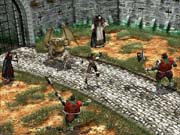
Unlike the gameplay elements, nothing from Disciples has been carried over into the sequel where presentation is concerned. The new game is being built from the ground up with a brand-new graphical engine. A sort of high-medieval theme has been adopted for the general appearance of the game's menu system, although much of this artwork is expected to be replaced by new material in the coming weeks. Patrick Lambert is back with more of the hand-painted art that so memorably characterized the first game. He's once again providing the look of the individual characters through some incredibly detailed portraits that somehow evoke fantasy archetypes and defy convention at the same time.
In-game detail has also been the focus of some attention. While devastated from the ongoing conflicts, the Sacred Lands have never looked better...or at least never more realistic. All sorts of interesting terrain features have been added, such as waterfalls and rivers. Combat now takes place from a close-up vantage point that enables you to appreciate the animation of more than 200 units and more than 100 spells. If you identified with your party members before, wait until you can see them fight and die from a front-row seat.
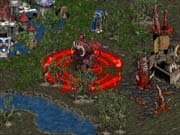
Audio has also been worked on. Strategy First has beefed up the budget for Disciples II, adding better sound equipment and access to a greater pool of voice talent. This should be a considerable boon, considering how poor voice acting hampered gamers' immersion in the original game.
Finally, the design team is spending time making sure that Disciples II is a more rounded product. This includes hot-seat, LAN, and Internet multiplayer modes that support up to four players and a lot of customization options right out of the box. For starters, the game will ship with a full campaign editor. A full suite of development tools will be available, so expect home-brewed campaigns and multiplayer scenarios to start popping up on Web sites within days of the game's arrival in stores. Also, high-level leaders can now be exported from campaigns, allowing the design of more powerful scenarios (leaders couldn't be exported in the last game, so you had to begin all campaigns at the first level).
From what we've seen of these early builds, Disciples II: Dark Prophecy has the potential to surpass the original game in every way. Rather than knocking off a quickie sequel with a few more units, Strategy First has taken the time to carefully appraise what was good about the first game and determine what needed work and what needed to be left well enough alone. In some cases, what the design team didn't do, as opposed to what it did do, might be more noticeable in the final product. Regardless, we'll all find out for ourselves how successful this approach will be when the game reaches stores this fall.
Got a news tip or want to contact us directly? Email news@gamespot.com
Join the conversation